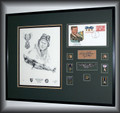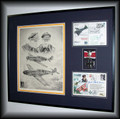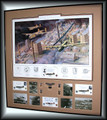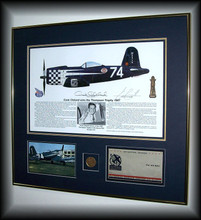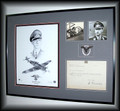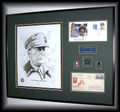 Loading... Please wait...
Loading... Please wait...Categories
Our Newsletter
- Home
- Frmd Collectibles ~ 35% OFF ~ Free Shipping
- Race #74 wins The Thomson Trophy 1947 by Ernie Boyett (signed by: Cook Cleland) ~ 35% Off ~ Free Shipping
Product Description
Frame Size: 21" x 23" ~ autograph print signed by: Race Pilot Cook Cleland. Comes with a COA.
Cook Cleland wins The Thompson Trophy 1947 ~ F2G Corsair #74
When he returned to civilian life after World War II, the Cleveland, Ohio, native had more than the usual on his mind. He wanted to put the skills and experience he had gained flying fighter planes to some use. The obvious opportunity was to pylon air racing, as the Cleveland National Air Races were about to be resumed after a long pause.
Cook bought a slightly used Vought FG-1D Corsair for less than the value of the gasoline in its tanks, and set out to turn it into a racer. He removed all the unnecessary military equipment: guns, armor plating and heavy radios. The airplane got a general clean-up, a sporty maroon-and-cream paint job and a good waxing. "Lucky Gallon" was ready to face a field of surplus Army airplanes as one of the few ex-Navy competitors.
With its 2,000 hp Pratt & Whitney 18-cylinder engine screaming, it carried Cook to the finish line of the 1946 Thompson Trophy Race at an average of 357 mph. This was almost 75 mph faster than the pre-war record. But it was 17 mph behind an Army P-39 Airacobra. Losing to the Army was definitely not what Cleland had in mind.
He soon discovered that a special version of the bent-winged Corsair would soon go on the surplus market, and with the assistance of a friendly admiral who also wanted to see the Navy whip the Army, was able to buy three of them before anyone else got a chance.
The hefty Goodyear F2G-1 Super Corsair looked like the standard model except for the engine, which was a huge 28-cylinder Pratt & Whitney Wasp Major rated at more than 3,000 hp. It had been designed to deal with Japanese suicide planes that were causing great damage to American ships, but was not ready by the time the war ended.
The standard modifications were made, and Cook's airplane had its wings clipped a few feet. The result was a record-setting victory for Cleland at 396 mph for 20 laps of the 15-mile race course. His long-time friend Dick Becker placed 2nd in another F2G.
For 1948, the remaining two F2G's got major changes to their induction systems, including the addition of long carburetor air scoops. Cleland qualified 2nd for the Thompson Trophy Race at 417 mph, and Becker qualified 3rd at 406 mph. The top qualifier, in an Army P-39, was barely ahead, at 418 mph.
The race was but a few laps old when first Becker and then Cleland were forced out when their new air scoops blew loose following explosions in the induction systems. An experimental fuel, rated at 200 octane, proved too volatile.
More careful preparations were made for the 1949 race, including adding tip plates to the ends of the wings. A third F2G was added to the stable, and would be flown by Ben McKillen. Dick Becker qualified 1st at 415 mph, Cleland was 2nd at 407 mph. And McKillen was 4th at 396 mph. Becker, unfortunately, damaged his propeller reduction gears and was finished for the weekend.
Cleland dominated the race, winning at 397 mph, which remained the record for the class until the late 1960's. McKillen was 3rd behind another F2G pilot, giving the ex-Navy airplanes a clean sweep, something no type of airplane had ever done.
His 1947 winner is now being restored to museum condition, and McKillen's racer is once again flying and won for its restorer the Rolls Royce Trophy in 1999.

